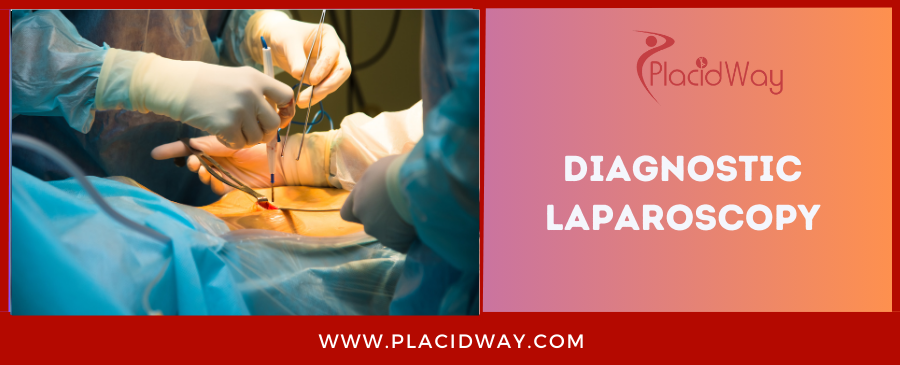
Unlocking Answers: What a Diagnostic Laparoscopy Can Reveal About Your Health
Are you experiencing persistent abdominal pain, unexplained pelvic discomfort, or struggling with fertility issues that remain a mystery? The journey to a clear diagnosis can often be frustrating, especially when standard tests don't provide the answers you need. For many, a diagnostic laparoscopy offers a powerful solution, allowing doctors to directly examine internal organs and identify the root cause of your symptoms with precision.
Often referred to as "keyhole surgery" or "exploratory laparoscopy," this procedure is a cornerstone in modern medicine, particularly in gynecology, gastroenterology, and general surgery. Instead of a large incision, a diagnostic laparoscopy involves tiny cuts, through which a thin, lighted tube with a camera (a laparoscope) is inserted. This allows the surgeon to see inside your abdomen or pelvis on a monitor, looking for abnormalities like endometriosis, adhesions, cysts, fibroids, or even early signs of cancer.
For patients around the world searching for answers to "why do I have this pain?" or "what's causing my infertility?", diagnostic laparoscopy represents a significant step forward. It’s a minimally invasive way to get a definitive diagnosis when imaging tests (like ultrasounds or MRIs) or blood tests aren't conclusive. If you're exploring options like "cost of diagnostic laparoscopy abroad" or "best place for laparoscopic diagnosis," you're likely seeking not just a diagnosis, but also high-quality, affordable care. This guide will walk you through everything you need to know about diagnostic laparoscopy, from symptoms and causes to recovery and how medical tourism can be a viable path to finding your answers.
What Exactly Is a Diagnostic Laparoscopy and Why Is It Performed?
A diagnostic laparoscopy is a surgical procedure that allows a surgeon to look directly at the organs inside your abdomen and pelvis. It’s called "minimally invasive" because it uses very small incisions, typically less than half an inch, compared to traditional open surgery which requires a much larger cut. The primary tool is a laparoscope, a thin, fiber-optic instrument equipped with a light and a high-resolution camera. This camera transmits real-time images to a video monitor, giving the surgeon a clear, magnified view of your internal structures.
People often search for "what is exploratory surgery for belly pain" or "laparoscopy for unknown abdominal pain," which perfectly describes the core purpose of this procedure. It’s performed when non-invasive diagnostic methods like X-rays, CT scans, MRIs, or ultrasounds haven't provided a definitive answer to a patient's symptoms. It helps physicians:
- Diagnose the cause of chronic abdominal or pelvic pain: Often, the source of persistent pain is hidden from external view.
- Investigate infertility: Identifying issues like endometriosis, fibroids, or blocked fallopian tubes that may hinder conception.
- Evaluate suspected growths or masses: Determining if a cyst or tumor is benign or malignant (biopsies can be taken).
- Stage certain cancers: Assessing the extent of cancer spread.
- Diagnose conditions like endometriosis, appendicitis, ectopic pregnancy, or adhesions.
- Confirm or rule out other conditions where a direct visual inspection is necessary for an accurate diagnosis.
Think of it like sending a miniature submarine with a camera into a mysterious cave to find out what's really inside, rather than trying to guess from the outside or digging a huge tunnel.
What Symptoms Might Suggest You Need a Diagnostic Laparoscopy?
If you've been living with symptoms that doctors haven't been able to pinpoint despite numerous tests, a diagnostic laparoscopy might be the next step. Patients frequently search for "symptoms requiring laparoscopy" or "when is exploratory laparoscopy recommended." Here are some common symptoms that could lead to this procedure:
- Chronic Pelvic or Abdominal Pain: This is one of the most common reasons. If you have pain that lasts for more than six months and doctors can't find a cause, it could be due to conditions like endometriosis, pelvic inflammatory disease, or adhesions (scar tissue).
- Unexplained Infertility: If you and your partner have been trying to conceive for over a year (or six months if over 35) without success, and other fertility tests are normal, a laparoscopy can reveal physical barriers like blocked fallopian tubes, fibroids, or severe endometriosis that affect fertility.
- Abnormal Growths or Masses: If an ultrasound or MRI reveals an ovarian cyst, uterine fibroid, or other suspicious mass in your abdomen or pelvis, a laparoscopy can help determine its nature – whether it’s benign, cancerous, or causing other problems.
- Symptoms of Endometriosis: Severe period pain, painful intercourse, chronic pelvic pain, heavy bleeding, and bowel/bladder issues during menstruation are hallmark symptoms. Laparoscopy is often the definitive way to diagnose and stage endometriosis.
- Suspected Ectopic Pregnancy: In urgent cases where an embryo implants outside the uterus, a laparoscopy can confirm the diagnosis and sometimes treat the condition.
- Persistent Digestive Issues: While less common, it can be used to investigate chronic appendicitis, certain bowel obstructions, or other gastrointestinal problems when other methods are inconclusive.
If these symptoms resonate with your experience, discussing diagnostic laparoscopy with your doctor could open the door to a clearer understanding of your health.
What Conditions and Causes Can Diagnostic Laparoscopy Help Uncover?
One of the greatest strengths of diagnostic laparoscopy is its ability to identify a wide range of conditions that are often invisible to other diagnostic tools. Patients often search for "what does a diagnostic laparoscopy find" or "conditions diagnosed by laparoscopy." Here are some of the key conditions and their underlying causes that this procedure can help diagnose:
- Endometriosis: A condition where tissue similar to the lining of the uterus grows outside the uterus. It's a major cause of chronic pelvic pain and infertility. Laparoscopy can visually confirm its presence and severity.
- Adhesions (Scar Tissue): Bands of scar tissue that can form after surgery, infection, or inflammation. These can "glue" organs together, causing chronic pain, bowel obstruction, or infertility.
- Ovarian Cysts and Tumors: While many cysts are harmless, laparoscopy can help determine if a cyst is problematic, take biopsies, or even remove it if necessary.
- Uterine Fibroids: Non-cancerous growths in the uterus that can cause heavy bleeding, pain, and fertility issues.
- Pelvic Inflammatory Disease (PID): An infection of the female reproductive organs, often a complication of STIs. Laparoscopy can assess its extent and resulting damage.
- Ectopic Pregnancy: A life-threatening condition where a fertilized egg implants outside the uterus, typically in a fallopian tube.
- Appendicitis: Though often diagnosed by imaging, atypical cases can be confirmed via laparoscopy.
- Certain Cancers: Used to diagnose and stage cancers of the ovaries, uterus, colon, or other abdominal organs, often by taking targeted biopsies.
- Unexplained Infertility Factors: Beyond specific conditions, it can reveal subtle issues affecting conception not visible on other tests.
- Chronic Pelvic Pain Syndromes: Helping to differentiate between musculoskeletal, nerve, or organ-related pain.
By offering a direct visual inspection, this procedure cuts through uncertainty, providing a precise diagnosis that guides effective treatment.
Who Is an Ideal Candidate for Diagnostic Laparoscopy?
The decision to undergo a diagnostic laparoscopy is made after careful consideration and usually when other, less invasive tests have failed to provide a clear answer. People often ask, "Am I a candidate for exploratory surgery?" or "who needs a diagnostic laparoscopy?". Here's who typically benefits:
- Patients with Persistent, Unexplained Pain: If you've been suffering from chronic pelvic or abdominal pain for months or years, and blood tests, ultrasounds, and CT scans haven't found a cause.
- Individuals Experiencing Infertility: Couples struggling with conception where female factor infertility is suspected, but other tests (like hormone levels, ovulation tracking, HSG) are normal or inconclusive.
- Those with Suspected Endometriosis: Especially if symptoms are severe and impacting quality of life, as laparoscopy is the gold standard for diagnosing endometriosis.
- Patients with Abnormal Imaging Results: If an imaging scan shows suspicious masses, cysts, or fluid in the abdomen or pelvis that require further investigation and possibly a biopsy.
- When Other Diagnoses Are Being Ruled Out: Sometimes, it’s necessary to confirm or exclude a specific condition (like appendicitis in atypical cases or an ectopic pregnancy) that requires direct visual confirmation.
- Patients Who Prefer Minimally Invasive Options: For those seeking a diagnostic method with less pain, smaller scars, and faster recovery than traditional open surgery.
However, it’s not for everyone. People with severe heart or lung disease, extensive prior abdominal surgeries leading to significant adhesions, or certain bleeding disorders might not be suitable candidates. A thorough medical evaluation with your doctor is essential to determine if diagnostic laparoscopy is the right choice for you.
What Does the Diagnostic Laparoscopy Procedure Involve?
Understanding "what happens during a diagnostic laparoscopy" can help alleviate anxiety. The procedure is usually performed under general anesthesia, meaning you'll be completely asleep and won't feel any pain. Here's a general overview of the steps:
- Anesthesia: You'll be given general anesthesia to ensure you are comfortable and pain-free throughout the procedure.
- Incisions: The surgeon will make one or more small incisions, typically 0.5 to 1.5 cm long. The primary incision is usually made at the edge of or inside the navel (belly button), making it less visible. Additional small incisions may be made in the lower abdomen to insert other surgical instruments if needed for better viewing or to take biopsies.
- Insufflation: Carbon dioxide (CO2) gas is gently pumped into your abdomen. This inflates the abdominal cavity, creating space between the organs and the abdominal wall. This "lifts" the abdominal wall, giving the surgeon a clear view and room to maneuver the instruments without touching other organs.
- Laparoscope Insertion: The laparoscope (a thin, lighted tube with a camera) is inserted through the primary incision. The images are projected onto a high-definition monitor in the operating room, allowing the surgical team to see your internal organs.
- Examination and Biopsy: The surgeon carefully examines the organs, looking for any abnormalities, inflammation, adhesions, cysts, fibroids, or other signs of disease. If suspicious tissue is found, small biopsy samples can be taken for laboratory analysis, or minor corrective procedures (like adhesion removal) might be performed during the same session if pre-approved and feasible.
- Closure: Once the examination is complete, the CO2 gas is released from your abdomen. The laparoscope and any other instruments are removed, and the small incisions are closed with stitches or surgical glue and covered with small bandages.
The entire procedure usually takes between 30 to 90 minutes, depending on the complexity of the case and what is found. You will then be moved to a recovery room for observation.
What Should I Expect During Recovery After Diagnostic Laparoscopy?
One of the main advantages of diagnostic laparoscopy over traditional open surgery is the quicker and generally less painful recovery. Patients often search for "recovery time for diagnostic laparoscopy" or "what to expect after keyhole surgery." Here's a typical recovery timeline:
- Immediately After: You'll wake up in a recovery room, likely feeling drowsy from the anesthesia. You might experience some discomfort at the incision sites, and a common complaint is shoulder pain. This shoulder pain is caused by the residual CO2 gas irritating the diaphragm, which shares nerve pathways with the shoulder. Moving around and gentle walking can help dissipate the gas.
- First 24-48 Hours (At Home):
- Pain Management: You'll be prescribed pain medication, or advised to take over-the-counter pain relievers.
- Incisions: Keep the incision sites clean and dry. You might have small bandages that need changing. Light bleeding or discharge is normal.
- Activity: Rest is crucial, but short, gentle walks are encouraged to prevent blood clots and help with gas discomfort. Avoid heavy lifting.
- Diet: Start with light foods and gradually return to your normal diet as tolerated.
- Fatigue: Expect to feel tired. Your body is recovering from anesthesia and surgery.
- First Week:
- Most discomfort should significantly decrease.
- You can usually return to light daily activities, like desk work or light chores.
- Avoid strenuous exercise, heavy lifting, and swimming (to protect incisions) for at least 1-2 weeks or as advised by your doctor.
- Full Recovery: Most people feel back to their normal selves within 1-2 weeks. Small scars will fade over time.
It's vital to follow your surgeon's specific post-operative instructions, especially regarding wound care, medication, and activity restrictions. Always contact your doctor if you experience severe pain, fever, redness/pus at incisions, or heavy bleeding.
What Are the Potential Risks and Side Effects of Diagnostic Laparoscopy?
Like any surgical procedure, diagnostic laparoscopy carries some potential risks and side effects, though serious complications are rare. It's important to be informed and discuss any concerns with your healthcare provider. Patients often inquire about "is diagnostic laparoscopy safe" or "risks of exploratory keyhole surgery."
Potential Risks (Rare but Serious):
- Infection: At the incision sites or internally, though sterile techniques minimize this risk.
- Bleeding: Internal bleeding, though usually minor, can sometimes require further intervention.
- Damage to Internal Organs: Very rarely, the instruments or insufflation needle can puncture an organ like the bowel, bladder, or blood vessels. This might require additional surgery to repair.
- Complications from Anesthesia: Reactions to medication, breathing problems, or other issues.
- Blood Clots: In the legs (deep vein thrombosis) or lungs (pulmonary embolism), though measures are taken to prevent this.
- Hernia: A very small chance of a hernia developing at an incision site.
Common Side Effects (Usually Mild and Temporary):
- Pain at Incision Sites: Mild to moderate discomfort where the cuts were made.
- Shoulder Pain: As mentioned, this is due to residual CO2 gas irritating the diaphragm and usually resolves within a day or two.
- Bloating and Abdominal Discomfort: From the gas used to inflate the abdomen.
- Nausea and Vomiting: Often a side effect of anesthesia, usually short-lived.
- Fatigue: Feeling tired for several days post-procedure is normal.
- Sore Throat: If a breathing tube was used during anesthesia.
Your medical team will take every precaution to minimize these risks, and a thorough pre-operative assessment will help identify any personal risk factors you may have.
How Much Does a Diagnostic Laparoscopy Typically Cost Globally?
The cost of diagnostic laparoscopy can vary dramatically depending on your geographical location, the hospital, the surgeon's fees, anesthesia costs, and whether any immediate corrective actions (like adhesion removal or cyst drainage) are performed during the procedure. Patients frequently search for "diagnostic laparoscopy cost," "laparoscopy prices abroad," or "affordable exploratory surgery."
| Country | Average Cost Range (USD) | Key Considerations |
|---|---|---|
| USA / Canada | $5,000 - $15,000+ | High-quality care, but often not covered well by insurance for diagnostic purposes or with high deductibles. |
| UK (Private) | £3,000 - £7,000 (~$3,800 - $9,000) | Similar to USA, private healthcare can be expensive; NHS waiting lists for non-emergency. |
| Mexico | $1,500 - $3,500 | Popular for affordability, proximity for North Americans, and growing medical infrastructure. |
| India | $1,200 - $3,000 | Very competitive prices, highly skilled surgeons, internationally accredited hospitals. |
| Turkey | $2,000 - $4,000 | Modern facilities, experienced doctors, strategic location for European/Middle Eastern patients. |
| Thailand | $2,000 - $4,000 | Excellent hospitality, state-of-the-art hospitals, known for medical tourism. |
| Costa Rica | $2,000 - $3,800 | Good option for North Americans seeking quality care in a beautiful setting. |
These prices are estimates and can vary. They typically include surgeon's fees, anesthesia, facility fees, and initial post-op care. It's crucial to get a detailed quote that specifies what is included.
Why Consider Diagnostic Laparoscopy Abroad and Which Countries Offer the Best Value?
For many, the decision to undergo a medical procedure abroad, often referred to as "medical tourism," is driven by a combination of factors. When considering a diagnostic laparoscopy, these factors become even more compelling. Patients often search for "benefits of medical tourism for diagnosis" or "best places for affordable laparoscopy."
Why Consider Diagnostic Laparoscopy Abroad?
- Significant Cost Savings: As shown in the table above, the cost of diagnostic laparoscopy can be dramatically lower in other countries—often 50% to 70% less than in Western nations—without compromising on quality. This is especially beneficial for those without adequate insurance coverage or facing high deductibles.
- Shorter Waiting Times: In countries with universal healthcare systems, non-emergency diagnostic procedures can have long waiting lists. Traveling abroad allows patients to receive prompt attention and a quicker diagnosis.
- Access to Advanced Technology and Specialists: Many medical tourism destinations boast state-of-the-art hospitals with cutting-edge equipment and highly trained surgeons, often educated in Western countries.
- High-Quality Care and Personalized Attention: Many international hospitals catering to medical tourists offer exceptional patient care, luxurious facilities, and personalized services, including dedicated patient coordinators and language support.
- Privacy and Anonymity: Some patients prefer to receive sensitive medical care away from their home country.
- Combine with a Vacation: The recovery period for diagnostic laparoscopy is relatively short, allowing some patients to combine their medical trip with a relaxing vacation.
Which Countries Offer the Best Value for Diagnostic Laparoscopy?
Based on a combination of affordability, quality, and patient experience, several countries stand out:
- Mexico: Especially popular for North American patients due to proximity, offering excellent facilities in cities like Tijuana, Cancun, and Monterrey.
- India: A global leader in medical tourism, known for highly skilled surgeons, advanced technology, and exceptionally competitive pricing.
- Turkey: Offers a blend of modern healthcare infrastructure, experienced professionals, and cultural richness, particularly appealing to European and Middle Eastern patients.
- Thailand: Renowned for its hospitality, top-tier private hospitals, and attractive tourist destinations, making recovery a pleasant experience.
- Costa Rica: An emerging destination, offering high-quality care, beautiful natural surroundings, and a strong focus on patient experience.
When selecting a destination, research accredited facilities (e.g., JCI accreditation) and reputable medical tourism facilitators like PlacidWay to ensure a safe and successful experience.
What Should You Expect When Traveling for Diagnostic Laparoscopy Abroad, and How Can You Ensure Quality?
Traveling for medical care requires careful planning, but with the right approach, it can be a smooth and rewarding experience. Patients often ask, "what to prepare for medical trip abroad," "how to find good hospitals overseas," or "patient success stories medical tourism."
What to Expect When Traveling for Your Procedure:
- Initial Consultation and Planning: You'll typically start by consulting with a medical tourism facilitator like PlacidWay. They will help you gather your medical records, get remote consultations with international specialists, compare quotes, and choose a suitable hospital and surgeon.
- Logistics and Travel: Your facilitator can assist with travel arrangements, including flights, accommodation (often near the hospital), and local transportation. Many hospitals offer airport pickup and dedicated patient coordinators.
- Pre-Operative Care: Upon arrival, you'll have in-person consultations with your surgeon and anesthesiologist, undergo any necessary pre-op tests, and discuss the procedure in detail.
- The Procedure and Hospital Stay: You'll undergo the diagnostic laparoscopy. Depending on your recovery, you might stay in the hospital for a day or be discharged the same day for outpatient recovery.
- Post-Operative Recovery and Follow-up: You'll recover in your accommodation, attending follow-up appointments. Most patients need to stay in the destination country for at least 7-10 days after a diagnostic laparoscopy to allow for initial recovery and a final check-up before flying home.
- Results and Aftercare: Biopsy results will be discussed, and a clear diagnosis provided. Your medical records will be prepared for you to take back to your local doctor for continued care.
How to Ensure Safety and Quality Abroad:
- Choose JCI-Accredited Hospitals: Joint Commission International (JCI) accreditation signifies that a hospital meets rigorous international standards for patient care and safety, similar to those in Western countries.
- Verify Surgeon Credentials: Research your surgeon's qualifications, experience with diagnostic laparoscopy, and board certifications. Many international surgeons have training from top Western institutions.
- Read Patient Testimonials and Reviews: Look for feedback from previous international patients. PlacidWay often shares patient success stories that can offer valuable insights and reassurance.
- Use a Reputable Medical Tourism Facilitator: Companies like PlacidWay act as your advocate, vetting providers, coordinating all aspects of your trip, and ensuring transparent communication. They help mitigate risks and simplify the process.
- Understand the All-Inclusive Package: Ensure your quote includes all costs: surgeon's fees, anesthesia, hospital stay, medications, and any follow-up consultations before you return home.
- Prepare for Communication: Confirm that the medical staff and your facilitator can communicate effectively in your language.
By taking these steps, you can confidently pursue high-quality, affordable diagnostic laparoscopy abroad, finally uncovering the answers to your health questions and paving the way for effective treatment.
Take the Next Step with PlacidWay
Ready to explore treatment options abroad? Discover top clinics, compare prices, and get a free quote tailored to your needs with PlacidWay.
Cheap Gyn Surgical Procedures Packages










Share this listing